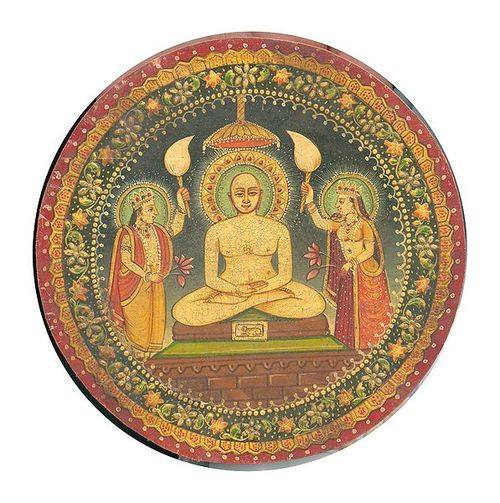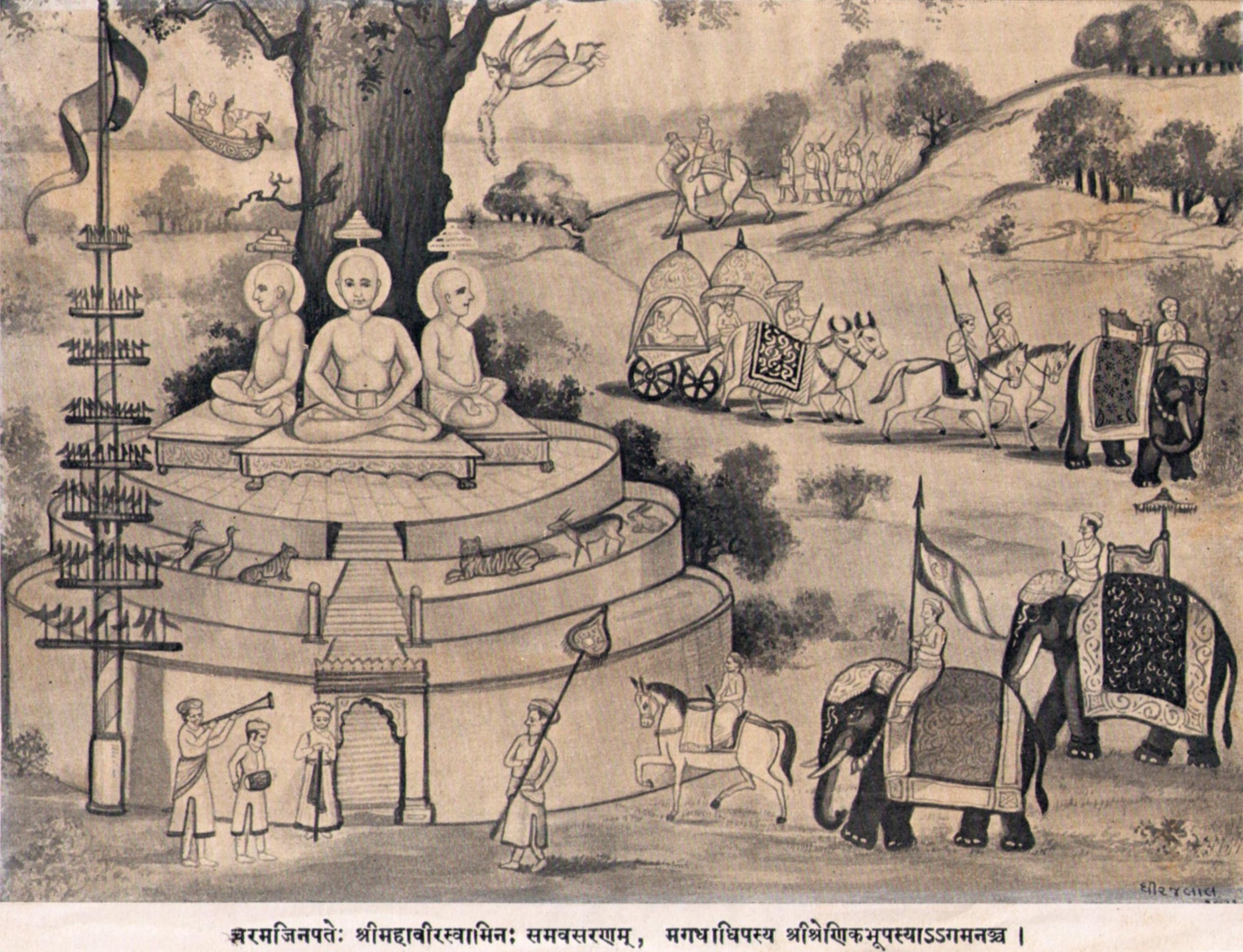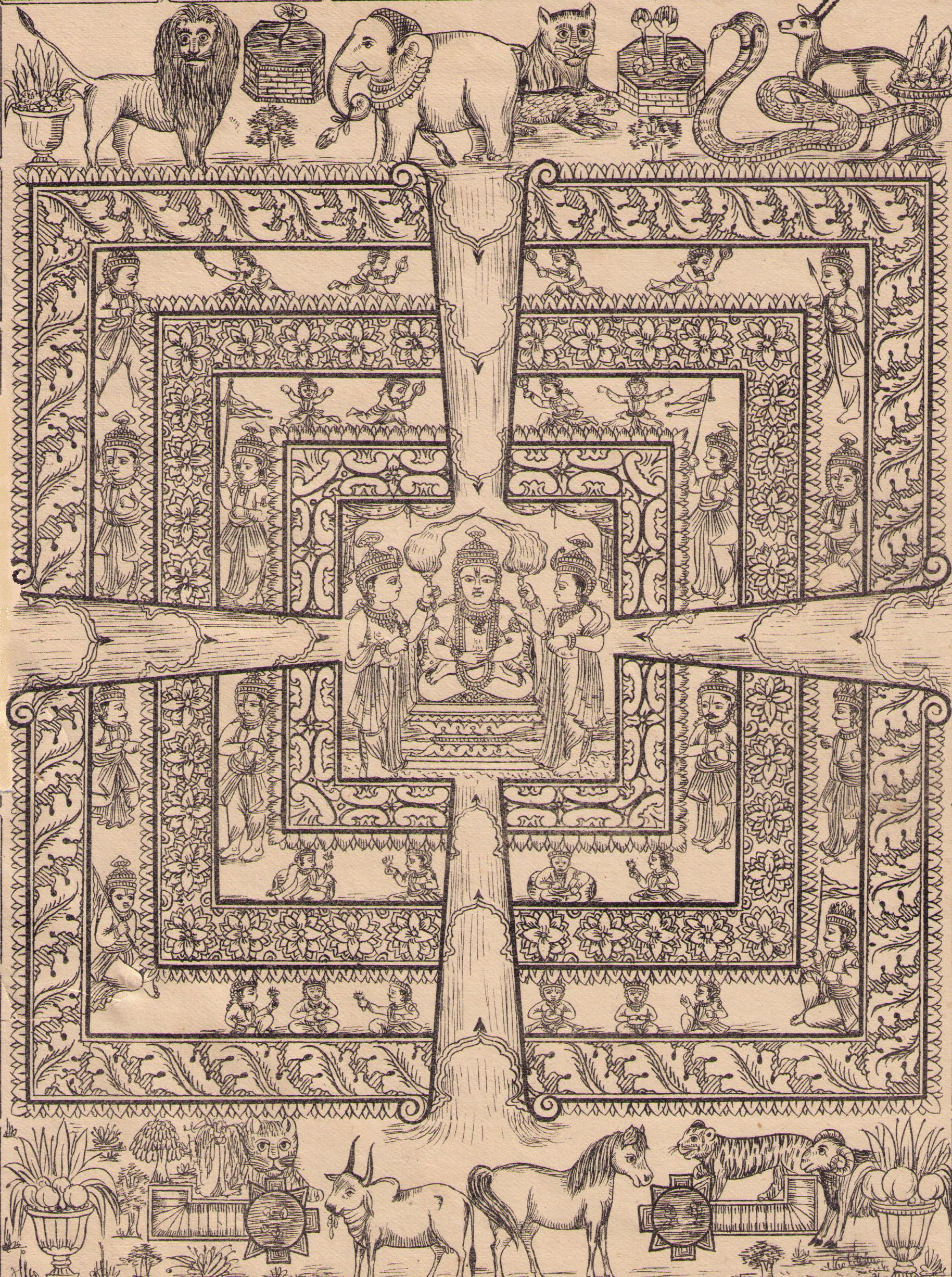
After the World's Parliament of Religions, held 1893 in Chicago, where Jainism was presented first to an interested public, a number of books and essays had been published on Jain dharma as the root of Christian doctrine. In this context the following text by Elisabeth Fraser must be seen as the result of the first encounter of Jainism and western culture on a par, and as an important source of contemporary religious history as well. The following text bases on a chapter of the nearly unknown work “A Scientific Interpretation of Christianity” by Elisabeth Fraser (published 1940 by C. R. Jain, London) and has been reissued later in the introductory section of the eight-volume edition Śramaṇa Bhagavān Mahāvῑra by Muni Ratna Prabha Vijaya (Volume I, Part I: Life, Ahmedabad: Śri Jaina Siddhānta Society, 1948, second edition, pp. 89-95).
The Origin of Religion
Almost all the world's religions accept the theory of Karma in one way or another; that is either openly or secretly. If they are properly studied it will be seen that they believe also in a Nirvāṇa - again either openly or secretly. But in all the mythological religions, the conceptions of Karma and Nirvāṇa are vague and obscure and improperly understood. Even in Buddhism, it is denied that the Karmic bondage is material in its nature, while Nirvāṇa actually stands for annihilation. No doubt Buddha believed in and spoke, at times, of the permanence - the Eternity of Nirvāṇa - but he did not believe in the existence of a Soul and not once did he affirm it. His idea of permanency or eternity, therefore, fixed itself on the condition of Nirvāṇa and not on the Soul which for him did not exist. In other words, Buddha maintained the belief that once release from Karma was obtained by or through annihilation, it could not be formed afresh. On this account alone, then the display of so much ignorance of the soul and its nature and apart from anything else, Buddhism can quite easily be left out of consideration as a possible source of Religion. The fact that it is also no more than two thousand five hundred years old, further excludes any other claim it might have; for Religion is surely much older.
On the same ground of recency we may also exclude from consideration the Semitic group of religions, viz. Judaism, Christianity and Mohmmadanism. This leaves us with Jainism, Hinduism, Zoroastrianism, Taoism, and the ancient religions of Egypt and Greece. They are all united in teaching the same thing - the Doctrine of Nirvāṇa. They must therefore have had a common source. The question that confronts us is: "Where is this source?" It cannot be outside of them, for there is nothing to suggest the existence of any other religion, that might be deemed to have taught the doctrine of Nirvana.
When we study Jainism, we find a complete explanation of the theory of Karma, a detailed description of soul-nature, and likewise of the state of Nirvāṇa. In addition, the biographies of a very large number of men who have actually attained the Summum Bonum are also given. But this is not so with any other of the religions we have just named. In no other religion do we find these three features. In other creeds, the description of soul-nature is hazy and vague, either misunderstood or only half-comprehended. In the same way, any account they give of Karma is unscientific, and inadequate. Furthermore, there are no biographies of men who attained Nirvāṇa, as are possessed by Jainism. In fact, no other religion can lay claim that any of its adherents have ever attained that Blessed State.
What however, is most significant and to be carefully borne in mind, when we study Jainism as a possible source of Religion is the fact that it is the only non-allegorical religion - the only creed that is a purely scientific system of religion which insists upon and displays a thorough understanding of the problem of life or soul. No other religion can lay claim to this distinction. All others are unscientific, dressed up in the garments of allegory, and myth, and metaphor, yet daring to masquerade as Truth. Certainly those artistic dabblers in Truth - the people who composed the allegories - must have been acquainted with the principles which they personified as gods and goddesses. For fact must always precede allegory. But clearly they were not omniscient men. Had they been, they would have foreseen the disastrous outcome of their pastime of allegorising - the shedding of blood, the bitter feuds that have arisen from the concealment of Truth, in a misconceived, misleading garb that hides effectively its real nature.
The conclusion to be reached from a study of Comparative Religion is that the only thoroughly practical creed is Jainism. And for the simple reason that it was founded by omniscient men who did not resort to allegory in their loving labour of spreading Truth. Being omniscient they would foresee the consequence of such folly.

The Jains believe that Religion is a science. For them, Religion is either a set of natural laws based on fact or fiction. Either the one or the other; there being no intermediate place for it. They hold that, that which cannot be conceived clearly and definitely, which, in short, is unreliable, is not a foot. Only that which is certain, definite, and reliable can be termed fast. And fact is ever amenable to rational explanation and scientific treatment. Arguing thus, Jainism is the only religious System that recognises clearly, the truth that religion is a science, as it must be, if it is to be of any use at all. It is for this reason that Jainism is the only man-made religion - the only one that reduces everything to the iron laws of nature, and with modern science, refuses and has always refused to acknowledge the existence of a God who is at once the creator and manager of a universe that by its very nature can be neither created nor managed. Putting Religion thus on a scientific basis it is worth while to investigate the Jaina claim that full, penetrating all-elucidating light is to be found only in Jainism. As a matter of fact, it is only Jainism which realises that the question of the origin of Religion in a world that is eternal and uncreated does not arise. It is perfectly true when the Jains say that Religion originated with man and that the first deified man of every cycle of time is the founder of Religion. Whenever a Tīrthaṅkara arises he re-establishes the scientic truths concerning the nature of Life and these truths are collectively termed Religion.
Since Jainism is the only religion that lays claim to having produced omniscient men, it does seem plain that Religion does originate from the Jains, that Ṛṣabha Deva - the first perfect man of the current cycle of time - was the Founder of Religion as taught by the Jains, for even the Hindus admit the Jaina claim that he is the founder of Jainism; that it was founded very very far back in time, countless untold millenniums ago, shortly after the first clouds began to form in the sky and the first water to descend on earth. We can only conjecture as to what really happened but it would seem that after a long time and at a period when there were no omniscient men to give warning, certain of the followers of Jainism who happened to be endowed with a fanciful imagination allied to poetical genius, had the idea of originating a new and pleasant pastime for whiling away the many idle moments they seem to have had. They to toy with the Word of Truth and gradually to personify some aspects of the Doctrine as gods and goddesses building elegant imaginative myths round them. Their work seems to have been much appreciated and their hidden charm to have proved so attractive that men of all classes and all lands took up the cult with enthusiasm. With the result that every body tried to outvie his neighbour in the new art of clever disguise, and the Word of Law was literally smothered under the prolific productions.of poetic fame and came finally to be lost to view.
After a time, temples and pagodas were built to house representatives of those mythological conceptions of the mind and the uninitated masses were invited and encouraged by the new priestly class that arose, to worship these man-made deities. Then later still, the rabble turned the tables and then sprang up a sharp division between the esoterics and the exoterics - the priests who held the secret and the vulgar laity who fed them. Men are not born with an understanding of the secret significance of allegorical myths and it came to pass that the masses became firmly fixed in their belief in the exoteric faith which alone was known to them. Intolerance of any other view began to wax strong in them. As it grew stronger, it led invariably to religious persecution. The number of esoterics dwindled. Matters eventually came to such a pass that no esoteric dared preach the truth openly. It was at this time, that the wisdom of secret initiation was recognised and the first institutions and mystery-lodges were established for the purpose. They went by different names in different countries but the fundamental aim was the same - the resurrection of Life - the Son or the Son of God from the dead.
The estrangement between those who followed the word of Tīrthaṅkara in its unadorned, undisguised form, and the esoterics themselves, fostered as it was by the latter who had to keep up appearances before the rabble, became more and more pronounced. Finally the branch set itself up in opposition to the Tree, and up to the present time, is still engaged in vociferously denying its relationship with the Source, calling it now atheistic, now devoid of sense, now the destroyer of Religion.

The last-comers in the Religions - the mushroom growths of modern times are those which have sprung up either as reformers of existing creeds or who have tried to strike out into paths that run parallel but little to the ancient tracks. They have had no Revelation - their knowledge is derived mostly from the misunderstood word of some ancient scripture on to which they have fastened themselves. It is possible to come across gleams of real insight here and there in some of their works; but this is only because a reformer stopped to ponder at some particular spot in the course of his rush through the corridor of myth and mythology.
It is not possible at this late date to determine the exact times of the appearance of the various Religions. But to a great extent, the order of their appearance can be deduced. As we have already established, Religion started with the Jains in India as a Science of Salvation. Outside India, no one else has ever claimed to have obtained Salvation and certainly Religion has never worn elsewhere the scientific aspect that it does in Jainism. Then came the first allegorists - Jains of course - and their method came to be copied far and wide. The descendents of these Āryan allegorists of India, are known today as Hindus and the Ṛgveda is probably the oldest allegorical Scripture in the world. Next arose the sect which popularised sanguinary sacrifice. They misinterpreted the allegorical text and began to offer up animals on the sacrificial altar, until after a very long time, a wave of reaction against it set in.
After the Nirvāṇa of the twenty-second Tīrthaṅkara, scientific Religion seems to have suffered an eclipse and almost to have disappeared for a time - until in fact, the appearance of the twenty-third World Teacher in the ninth century B.C. In his time, there seems to have been some upheaval in Indian metaphysical thought. It is probable that at least five out of the six schools of Hindu Philosophy originated during his lifetime, becoming fixed in their present form a few hundred years later. It is also very probable that the religions of the Parsees, the Jews, rand of the Chinese Lao Tse, were founded round about this time.
It was in the sixth century B.C. that the seed of Christianity was taken from India; although the Gospels were written some centuries later. Buddhism was born during the life-time of the last Tīrthaṅkara as a compromise between the exclusiveness of the Hindus and the rigid disciplinary asceticism of the Jains. Certainly Buddha was not born in the religion he founded. He was the disciple of various teachers including the Jainas, until he struck out for himself a new path. The various systems of Mysticism that arose in different Countries are all naturally posterior to the main creeds. Having thus traced the History of Religions, it would certainly seem that we may take Jainism to be its source.
To refer again to Christianity, it has already been said that it was taken from India in the sixth century B.C. Its doctrines agree in every particular with Jainism, and as C. R. Jain has shown in his Interpretation of St John's Revelation, the twenty-four Elders of that book, are the Tīrthaṅkaras of Jainism. The countless number of Siddhas (Perfect Souls) in Jainism are also to be found in the Book of Revelation. The same conceptions of Karma, of the inflow and stoppage and riddance of matter in relation to Karmic activity, are common to both the religions. The description of the condition of the Soul in Nirvāṇa is identically the same and the same is the case with the natural attributes of soul substance. This is a hundred percent agreement. There may be some agreement between Christianity and other religions on a few points, but never hundred percent. This is sufficient to show that Christianity was taken from Jainism. When was it taken?
In Mahāvir's time; for two reasons: Firstly, because it is not likely that the teaching about the Four and Twenty Elders could have been adopted from a distance, or from heresy, so that somebody must have actually seen the glory of Tīrthaṅkara-hood in the person of Mahāvīra, and accepted the teaching about the earlier twenty-three Tīrthaṅkaras also. Secondly, there are some texts in the Gospels which show that they were pronounced at a time when Nirvāṇa was still attainable by humanity on our globe - that is beyond two thousand four hundred years ago - during which period it has ceased to be attainable. One of these texts says: "There be some standing here, which shall not taste of death, till they see the Son of Man coming in his kingdom." Its real import is the attainment of Nirvāṇa and since Nirvāṇa ceased to be attainable over two thousand four hundred years ago, it must therefore have been uttered in the sixth century B.C. or earlier. European scholarship has also shown that the seeds of Christianity were sown centuries before the supposed date of Jesus. Bearing all these facts in mind, there can be no doubt that Christianity originated in the time of Mahāvīra himself.
 Elisabeth Fraser
Elisabeth Fraser